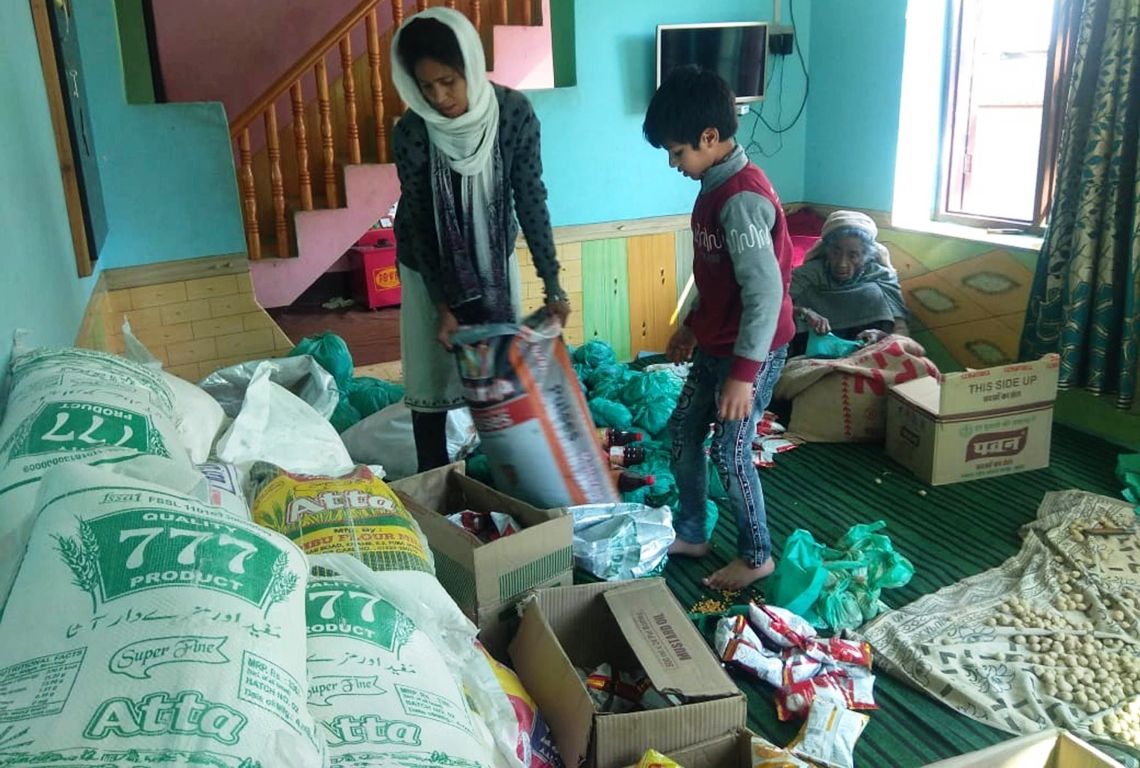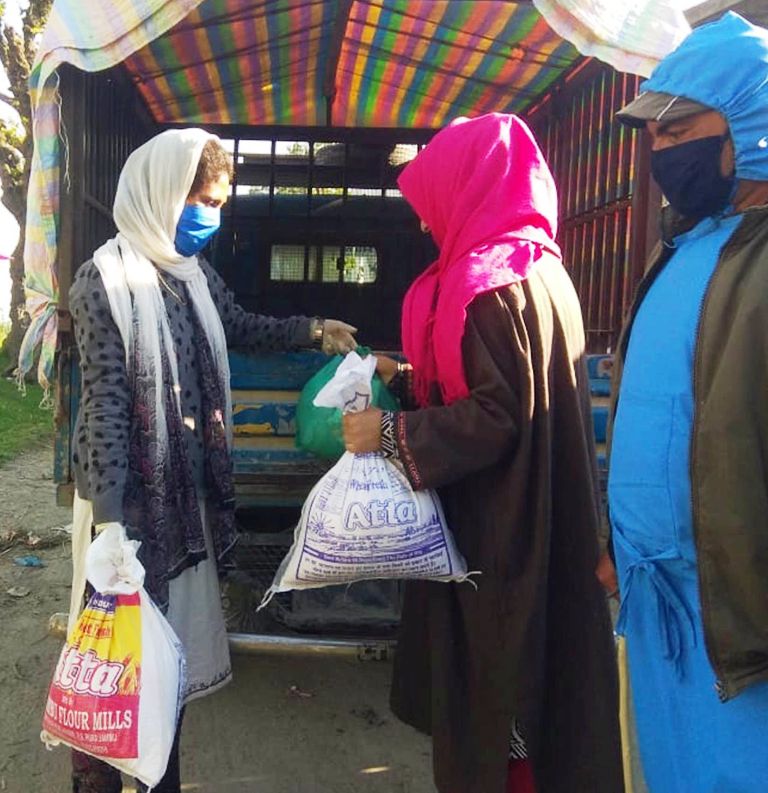As the worst affected area grapples with the pandemic, a lone woman is out on the streets helping the poor and needy, reports Saima Bhat

Declared as a Coronavirus hotspot, Hajin belt is now a no go area. Within the area, a non-descript Danger Mohalla is probably the first community transmission area of Kashmir.
Huge police and paramilitary contingent has been deployed to prevent people from moving without emergencies. The only permanent face moving around is Naziya Hurra, a woman in her late twenties.
A resident of the nearby Poshwari Naziya starts her day at dawn and does not rest till late evening. Going door to door every day around the area, she ensures that the poor and needy are helped. The population in the belt, mostly peasants, fall in the low-income groups of Kashmir.
Seen as messiah she has become a source of survival for many downtrodden families. The Hajin neighbourhoods long to see her.
Officially a “red zone” the area has currently 97 coronavirus-positive cases, the highest at one place in the union territory of Jammu and Kashmir.
Naziya’s schedule
Confined to her home since Kashmir witnessed the first positive case, Naziya received a distress call on the evening of March 23. A widow had nothing to cook. “A friend called that a widow and her differently-abled child has no food for dinner.”
The call, Naziya said, made her restless. She started thinking about such economically weak families of her locality, who cannot afford food without engaging in any daily labour. “The first thing I did was to check my wallet for the money. I had Rs 10000,” said Naziya.
She arranged a handcart and went to a local grocery with her brother. “We don’t have a vehicle, so a handcart came handy,” Naziya said.

From thereon, Naziya’s routine has changed completely. Soon after she finishes her breakfast she gets busy on her mobile phone. She checks with friends and relatives the genuine families in need of help.
By 10 am she starts packing different food items for the identified families. Her octogenarian mother, sister-in-law and nephew help her.
Every day she has a set target of serving 40 families. She leaves home after lunch at 2 pm and starts distribution up to 7 pm.
The packets, she says, include one litre of cooking oil, rice, half kg of pulses and salt tea, 1 kg each of soya chunks, turmeric, chilli powder, 5kg of flour, potatoes, and onions. Each packet she said, is sufficient for at least 10 days.
She has hired a local load carrier to reach different areas. “In the last 10 days, I have managed to reach around 700 families.”
Seeking help from her friends to sustain the effort, she used social media to reach out. “I asked if they can help in providing eatables. But a few couldn’t manage to do that so they transferred some money into my account. So far I have received Rs 30,000 in my account and the edibles worth more than Rs 20,000.”
She will continue the exercise through the holy month of Ramadan. “I have decided to go back to all these families again with the same package of food but with additions of powdered milk, dates, and semolina (suji),” Naziya said, after the initial relief to 700 families in 15 to 17 villages.
Despite the fact that her area has reported a maximum number of Covid-19 patients, Naziya goes about her work unfazed. With just an ordinary mask, a sanitizer and a pair of gloves she goes door to door to deliver the packets. “Believe me it gives me immense satisfaction. I have seen this despair closely. Whatever I can, I will ensure people don’t sleep empty stomach.”
After reaching home, late in the evening, her first stop is the washroom where she takes a bath and washes her clothes.
“I cannot risk the life of my mother, an asthma patient, and my two little nephews one of whom is a specially-abled child and Adnan.”
Tired after a hectic routine, she said: “her body aches and legs pain a lot.”
The Family
Naziya is the first in the family to pursue education. Struggling to survive, her father, Sonaullah Hurra, 70, and mother Bakhti Begum, 85, have three daughters and a son. Poverty forced them to stop the first three children from going to school. Naziya, however, turned out to be lucky.
Hurra, a farmer by profession, had around 10 kanals of paddy land and orchard but he couldn’t make enough savings to give a better living to his children. This struggle made his son and two daughters, all the three now married, to work from a very young age.
“We got a carpet weaving machine and started weaving carpets at home. As the days passed our earnings improved so the luckiest one, which was me got a chance to get enrolled in a local school,” said Naziya.
With the support of the family, she later completed her post-graduation in political science in 2015 and then did her bachelor’s in education (BEd).
In 2019, she enrolled in IGNOU to pursue Masters in Social Work. Naziya owes the spirit of social work to her nephew, who was born blind and is mentally unsound as well. She worked with a voluntary organisation that was attempting to provide education to the specially-abled. Then she joined them as a volunteer as well. It was Covid-19, however, that has brought her back to the field when most of her colleagues might be closeted to their homes.
The Hotspot
Hajin has become one of the major hotspots of Covid-19 in Kashmir. The area has already 97 positive cases till April 22, out of which 78 are active. One is dead and 18 have recovered so far.
The pandemic in the area surfaced with the sudden death of Ghulam Nabi Mir, a 65-year-old resident of the Gund Jahangeer area on April 7. Mir was declared Covid positive after his death. Two days later, twelve of his relatives also tested positive including his wife, two daughters and grand-daughters.
The case, however, was the concern. With no travel history or contact with a positive case, Mir, a fruit dealer, died within a day of his admission to Srinagar’s SMHS hospital.
According to Mir’s family, he had no travel history or contact with anyone. “He was bed–ridden because of multiple ailments like kidney dysfunction, cardiovascular problems, etc. And many people from the village used to call on him during his sickness,” said his son. “But nobody is aware if he got the virus from any of his visitors or he gave it to them”.
Since the day of his death, the area is adding numbers to the tally of positive cases each day.
As on April 22, at least 41 positive cases have been reported positive from this area only leading the administration to quarantine the village. This village has around 600 households and 3650 residents with locals largely dependent on farming, and 50 per cent of the total population living below the poverty line.
The administration is on toes to stop the spread. Last week, a 50-bedded quarantine centre was established in Hajin to help in the recovery process.
According to the official figures, 31 locals have been kept in hospital quarantine, 150 in administrative quarantine, and around 400 in home-quarantine. They account for almost 16 per cent of the total population. “Around 90 per cent of cases that tested positive were asymptomatic. We are dealing with a fluid situation, wherein everyone is a suspect. It has spread fast in the community,” said Syed Shahnawaz Bukhari, an officer on special duty in Bandipora.
As complete restrictions are in place, the administration has started the door-to-door survey. “So far 31 dedicated screening teams of health experts in 12 Red Zones of Hajin, Naidkhai, Gund Jahangeer, SK Bala, Batagund, Chandeergeer, Madwan, Hakbara, Kunan, Gund Qaiser, Gund Dachina, Nowgam, and Bonakoot, have screened 27,114 persons in a continuing process.”

On April 20, the district received its first consignment of Rapid Antigen Test (RAT) kits, and from the same day, the medical staff started conducting the tests at the doorstep of the people in the Red Zones. “41 RAT tests were conducted in the district on Monday, including 25 in Gund Jahangeer and Hajin while 16 were conducted in Bandipora town,” deputy commissioner Bandipora is quoted to have said.
With increasing cases of the Covid-19, the residents are psychologically disturbed. Confined to their homes, the entire population is feeling stressed. “We have now locked our doors and prefer to remain indoors most of the time. The administration should screen and test the entire village so that the extent of infection is known,” said a resident.
The History
For many, it is a repetition of history. In 1903, Hajin was engulfed by the last major plague. an epidemic. As written by A Mitra, the then Chief Medical Officer in The Indian Medical Gazetted (April 1907), that year the villagers helped in the burial of infected patients.
Mitra writes about a relative of an infected constable, who took the plague home to Kripalpur (Pattan). “After immediately disappearing, the plague recurred in a village on the Wullar lake shores, where it killed many people. They all had helped in the burial of a guest who had come from Geru to Gund Jehangir.”
“However, Shahgund and Bijpara villages near the lake proved stubborn plague centres. Shahgund proved unfortunate as it lost 269 people to the plague leaving barely 600 in 125 homes. Finally, the authorities completely relocated them to an open ground camp with enforced social distancing and removed the thatch roofs of their huts thus enabling sunlight to get in,” writes Mitra.
The crisis of the belt is rooted in its poverty. A majority of the population survives on the Wullar lake. They extract the water nuts and clean them to make a living. With the entire belt caught in the strict lock-down, the tensions and the crisis are too huge. Government apart, for the healthy survival, the area requires many such movements like that of Naziya.















